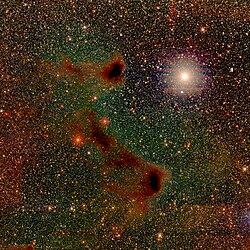Astronomy:H Scorpii
| Observation data Equinox J2000.0]] (ICRS) | |
|---|---|
| Constellation | Scorpius |
| Right ascension | 16h 36m 22.47192s[1] |
| Declination | −35° 15′ 19.1803″[1] |
| Apparent magnitude (V) | 4.18[2] |
| Characteristics | |
| Evolutionary stage | giant[3] |
| Spectral type | K6III[4] |
| B−V color index | 1.535±0.069[2] |
| Astrometry | |
| Radial velocity (Rv) | −2.10±0.7[5] km/s |
| Proper motion (μ) | RA: 15.61±0.17[1] mas/yr Dec.: 11.33±0.14[1] mas/yr |
| Parallax (π) | 9.52 ± 0.16[1] mas |
| Distance | 343 ± 6 ly (105 ± 2 pc) |
| Absolute magnitude (MV) | −0.84±0.037[6] |
| Details | |
| Mass | 1.06+0.74 −0.28 M☉[7] 1.81[8] M☉ |
| Radius | 52.79±5.47[3] R☉ |
| Luminosity | 389 L☉[7] 562 L☉[8] 582±147[3] L☉ |
| Surface gravity (log g) | 1.30±0.15[3] cgs |
| Temperature | 3,875±21[8] K |
| Metallicity [Fe/H] | 0.00±0.20 dex[3] −0.30[7] dex |
| Rotational velocity (v sin i) | 3.1[9] km/s |
| Age | 2.18[8] Gyr |
| Other designations | |
| Database references | |
| SIMBAD | data |
H Scorpii (H Sco) is a single[11] star in the southern constellation Scorpius. It is faintly visible to the naked eye with an apparent visual magnitude of 4.18.[2] The star is located at a distance of approximately 343 light-years from the Sun based on parallax measurements, but is drifting closer with a radial velocity of −2 km/s.[5] This star was initially given the Bayer designation Beta Normae by Lacaille but it was later reassigned from Norma to Scorpius.[12]
This is an aging giant star with a stellar classification of K6III.[4] After exhausting the supply of hydrogen at its core, this star cooled and expanded off the main sequence. It now has around 53 times the radius of the Sun.[3] The star is about 2.2[8] billion years old with only a mild level of magnetic activity, and is spinning with a projected rotational velocity of 3.1 km/s.[9] It is radiating 4–600 times the Sun's luminosity from its enlarged photosphere at an effective temperature of 3,875 K.[8]
References
- ↑ 1.0 1.1 1.2 1.3 van Leeuwen, F. (2007). "Validation of the New Hipparcos Reduction". Astronomy and Astrophysics 474 (2): 653–64. doi:10.1051/0004-6361:20078357. Bibcode: 2007A&A...474..653V.
- ↑ 2.0 2.1 2.2 Anderson, E.; Francis, Ch. (2012). "XHIP: An extended hipparcos compilation". Astronomy Letters 38 (5): 331. doi:10.1134/S1063773712050015. Bibcode: 2012AstL...38..331A.
- ↑ 3.0 3.1 3.2 3.3 3.4 3.5 Decin, L. et al. (March 2003). "ISO-SWS calibration and the accurate modelling of cool-star atmospheres. IV. G9 to M2 stars". Astronomy and Astrophysics 400 (2): 709–727. doi:10.1051/0004-6361:20021786. Bibcode: 2003A&A...400..709D.
- ↑ 4.0 4.1 Houk, Nancy (1979). Michigan catalogue of two-dimensional spectral types for the HD stars. 3. Ann Arbor, Michigan: Dept. of Astronomy, University of Michigan. Bibcode: 1982mcts.book.....H.
- ↑ 5.0 5.1 Gontcharov, G. A. (November 2006). "Pulkovo Compilation of Radial Velocities for 35495 Hipparcos stars in a common system". Astronomy Letters 32 (11): 759–771. doi:10.1134/S1063773706110065. Bibcode: 2006AstL...32..759G.
- ↑ Park, Sunkyung et al. (2013). "Wilson-Bappu Effect: Extended to Surface Gravity". The Astronomical Journal 146 (4): 73. doi:10.1088/0004-6256/146/4/73. Bibcode: 2013AJ....146...73P.
- ↑ 7.0 7.1 7.2 Charbonnel, C. et al. (2020-01-01). "Lithium in red giant stars: Constraining non-standard mixing with large surveys in the Gaia era". Astronomy and Astrophysics 633: A34. doi:10.1051/0004-6361/201936360. ISSN 0004-6361. Bibcode: 2020A&A...633A..34C.
- ↑ 8.0 8.1 8.2 8.3 8.4 8.5 Luck, R. Earle (2015). "Abundances in the Local Region. I. G and K Giants". Astronomical Journal 150 (3): 88. doi:10.1088/0004-6256/150/3/88. Bibcode: 2015AJ....150...88L.
- ↑ 9.0 9.1 Pérez Martínez, M. I. et al. (November 2014). "The non-active stellar chromosphere: Ca II basal flux". Monthly Notices of the Royal Astronomical Society 445 (1): 270–279. doi:10.1093/mnras/stu1706. Bibcode: 2014MNRAS.445..270P.
- ↑ "H Sco". SIMBAD. Centre de données astronomiques de Strasbourg. http://simbad.u-strasbg.fr/simbad/sim-basic?Ident=H+Sco.
- ↑ Eggleton, P. P.; Tokovinin, A. A. (September 2008). "A catalogue of multiplicity among bright stellar systems". Monthly Notices of the Royal Astronomical Society 389 (2): 869–879. doi:10.1111/j.1365-2966.2008.13596.x. Bibcode: 2008MNRAS.389..869E.
- ↑ Ridpath, Ian (June 28, 2018). "Norma, the Set Square". http://www.ianridpath.com/startales/norma.html.
 |


